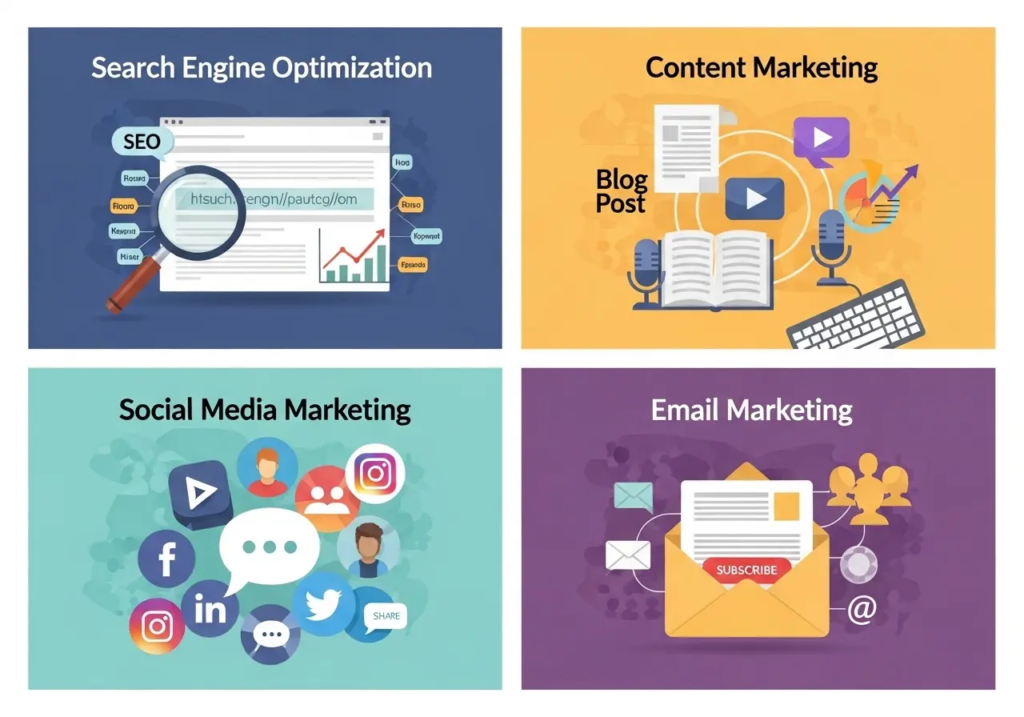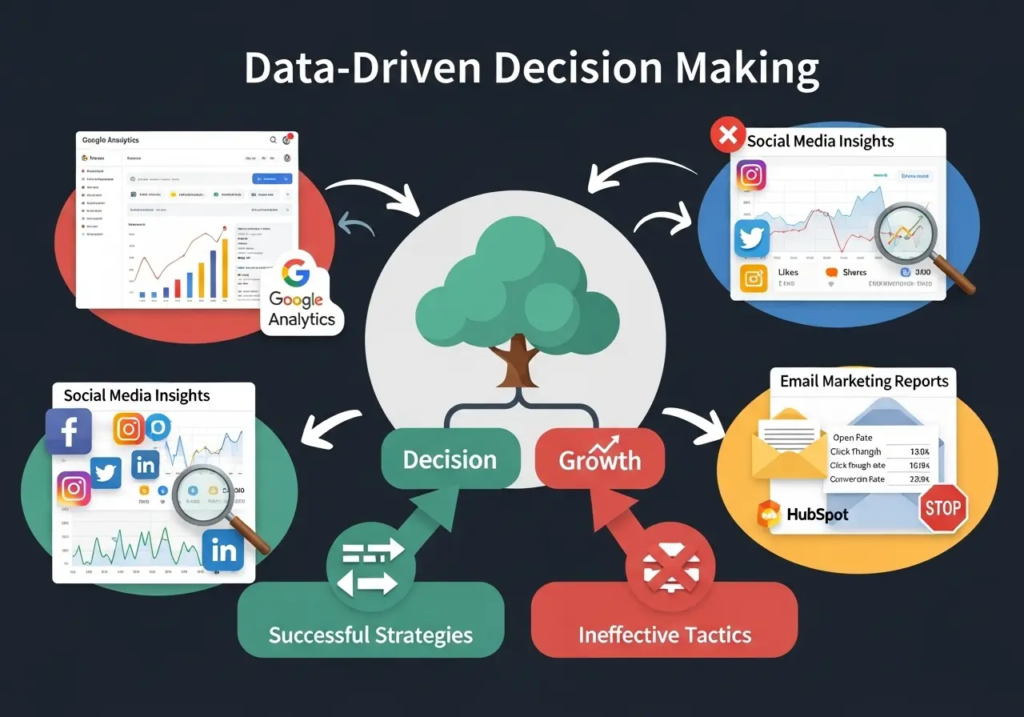Discover proven digital marketing strategies for small businesses that drive growth. Learn actionable tactics, tools, and tips to compete online effectively.

Table of Contents
- Introduction
- What Are Digital Marketing Strategies for Small Businesses?
- Types of Digital Marketing Strategies That Actually Work
- Core Principles Every Small Business Should Follow
- Essential Rules for Digital Marketing Success
- How to Create Your Digital Marketing Strategy (Step-by-Step)
- Most Effective Tools for Small Business Marketing
- FAQ
- Ready to Transform Your Business?
Introduction
Running a small business in today’s competitive landscape feels like David facing Goliath, right? While large corporations throw millions at their marketing budgets, you’re here wondering how to make every dollar count and see results that matter for your bottom line.
Here’s the reality that might surprise you: digital marketing strategies for small businesses aren’t just about having a website and posting occasionally on social media anymore. The game has evolved, and so have the opportunities for smart business owners who can leverage the right tactics at the right time.
What you’ll walk away knowing: By the end of this guide, you’ll understand exactly which digital marketing strategies work best for small businesses, how to implement them without breaking the bank, and which tools can help you compete effectively against much larger competitors. More importantly, you’ll have a clear roadmap to create your winning strategy that drives growth.
Let’s dive into the strategies transforming small businesses across every industry, turning modest marketing budgets into powerful growth engines.
What Are Digital Marketing Strategies for Small Businesses?
Think of digital marketing strategies as your business’s GPS online. Without them, you’re driving blindfolded, hoping you’ll stumble upon customers who need exactly what you’re selling.
Digital marketing strategies for small businesses are carefully planned approaches that use online channels to reach, engage, and convert your ideal customers into paying clients. Unlike traditional marketing that casts a wide net and hopes for the best, these strategies allow you to target specific audiences with laser-like precision.
What makes small business digital marketing unique is the need for maximum impact with minimal resources. You can’t afford to waste time on tactics that don’t directly contribute to your growth, which means every strategy must be measurable, scalable, and cost-effective.
The beauty of digital marketing lies in its democratizing effect. A local bakery can compete with national chains by targeting “fresh artisan bread near me” searches, while a freelance consultant can build authority through content marketing that rivals established agencies.
However, success requires more than just throwing spaghetti at the digital wall to see what sticks. You need a strategic approach that aligns with your business goals, understands your customer journey, and maximizes your return on investment.
Types of Digital Marketing Strategies That Actually Work
Digital marketing offers numerous pathways to success, but not all roads lead to profitable growth for small businesses. Let’s explore the strategies that consistently deliver results without requiring Fortune 500 budgets.

Search Engine Optimization (SEO)
SEO remains the cornerstone of sustainable digital marketing strategies for small businesses because it provides long-term visibility without ongoing advertising costs. When done correctly, SEO helps your website appear in front of people actively searching for your products or services.
Local SEO deserves special attention for brick-and-mortar businesses. Optimizing your Google My Business profile, collecting authentic reviews, and creating location-specific content can increase your visibility in local search results.
The key to SEO success lies in understanding search intent and creating content that helps your audience solve problems. Search engines reward businesses that provide valuable, relevant information rather than those trying to game the system.
Content Marketing
Content marketing transforms your business into a trusted resource rather than just another company trying to make a sale. By consistently publishing helpful, relevant content, you build relationships with potential customers long before they’re ready to purchase.
Blog posts, how-to guides, case studies, and industry insights establish your expertise while improving your search engine rankings. The compound effect of quality content means that articles you publish today can continue attracting customers for months or even years.
Video content deserves particular attention as it often generates higher engagement rates than text-based content. Short-form videos, tutorials, and behind-the-scenes content can humanize your brand and create deeper connections with your audience.
Social Media Marketing
Social media platforms offer unprecedented access to your target audience, but success requires strategic thinking rather than random posting. Each platform serves different purposes and attracts distinct demographics, so your approach must be tailored accordingly.
LinkedIn works exceptionally well for B2B companies and professional services, while Instagram and TikTok excel at reaching younger consumers with visually appealing products. Facebook’s mature user base and sophisticated targeting options make it valuable for most small businesses.
The secret to social media success lies in providing value before asking for anything in return. Share industry insights, respond genuinely to comments, and build authentic relationships with your followers.
Email Marketing
Despite predictions of its demise, email marketing continues delivering the highest return on investment among digital marketing channels. Building an email list gives you direct access to interested prospects and customers without depending on algorithm changes or platform policies.
Email sequences can nurture leads through your sales funnel, onboard new customers, and re-engage past clients. Personalization and segmentation significantly improve open and conversion rates compared to generic broadcast emails.
Automation tools allow small businesses to create sophisticated email campaigns that would otherwise require dedicated marketing staff. Welcome sequences, abandoned cart reminders, and post-purchase follow-ups can run automatically while you focus on other aspects of your business.
Core Principles Every Small Business Should Follow
Successful digital marketing strategies for small businesses are built on fundamental principles that remain constant despite changing technologies and platforms. Understanding these principles helps you make smart decisions about where to invest your time and money.
Customer-Centric Approach
Everything you do in digital marketing should involve understanding and serving your customers better. This means researching their pain points, preferences, and behaviors rather than making assumptions about what they want.
Create detailed buyer personas beyond basic demographics, including psychological motivations, preferred communication styles, and decision-making processes. These personas guide your content creation, advertising targeting, and overall messaging strategy.
Regular customer feedback through surveys, reviews, and direct conversations provides invaluable insights to improve your marketing effectiveness and products or services.
Consistency Across All Channels
Your brand message, visual identity, and tone of voice should remain consistent whether customers encounter you through search results, social media, or email marketing. Inconsistency creates confusion and weakens trust in your business.
Develop brand guidelines that specify your colors, fonts, logo usage, and messaging style. Even as a small business, professional consistency makes you appear larger and more established than competitors who neglect these details.
Regular posting schedules and consistent quality standards help build audience expectations and trust. It’s better to post with high quality less frequently than daily with mediocre content.
Data-Driven Decision Making
Gut feelings and industry best practices provide starting points, but actual performance data should guide your marketing decisions. Track metrics that directly relate to your business goals rather than vanity metrics that look impressive but don’t impact your bottom line.
Google Analytics, social media insights, and email marketing reports provide a wealth of information about what’s working and what isn’t. Regular analysis helps you double down on successful strategies while eliminating ineffective tactics.

A/B testing allows you to make incremental improvements over time. Test different headlines, images, call-to-action buttons, and posting times to optimize your results continuously.
Essential Rules for Digital Marketing Success
Navigating the digital marketing landscape becomes much easier when you follow proven rules that prevent common mistakes and accelerate success. Thousands of small businesses across various industries have tested these guidelines.
Focus on Quality Over Quantity
The temptation to be everywhere at once often leads to mediocre results across all channels. Instead of spreading yourself thin, choose two or three marketing channels and excel at them before expanding to others.
High-quality content that genuinely helps your audience will outperform dozens of shallow posts every time. Search engines and social media algorithms increasingly favor content that generates engagement and provides value.
Building a smaller, highly engaged audience proves more valuable than accumulating thousands of followers who never interact with your content or purchase your products.
Understand Your Customer Journey
Modern customers rarely purchase immediately after discovering your business. They typically research options, compare alternatives, and seek social proof before making decisions.
Map out your customers’ typical journey from initial awareness to final purchase. Create content and touchpoints that support them at each stage rather than constantly pushing for immediate sales.
Top-of-funnel content should educate and build awareness, middle-funnel content should address specific concerns and comparisons, while bottom-funnel content should remove final obstacles to purchase.
Integrate Online and Offline Experiences
Digital marketing strategies for small businesses work best when complementing rather than replacing offline interactions. Your digital presence should enhance your in-person customer service and sales processes.
QR codes on printed materials can bridge the gap between offline and online experiences. Social media check-ins and reviews can amplify positive offline experiences to reach new audiences.
Collect email addresses and social media follows during in-person interactions to continue building relationships digitally. Your best customers often become your most effective online advocates.
How to Create Your Digital Marketing Strategy (Step-by-Step)
Creating an effective digital marketing strategy doesn’t require a marketing degree or expensive consultants. Follow this systematic approach to develop a plan that aligns with your business goals and available resources.

Step 1: Define Your Goals and Objectives
Start by identifying what you want to achieve through digital marketing. Vague goals like “get more customers” won’t provide the direction for strategic decision-making.
Specific objectives include increasing website traffic by 50% within six months, generating 100 new email subscribers monthly, or improving online review ratings to 4.5 stars or higher.
Ensure your goals follow the SMART criteria: Specific, Measurable, Achievable, Relevant, and Time-bound. This framework helps you track progress and adjust strategies when necessary.
Step 2: Research Your Target Audience
Understanding your ideal customers goes far beyond basic demographics like age and location. Dive deeper into their motivations, challenges, preferred communication channels, and purchasing behaviors.
Conduct surveys with existing customers to understand why they chose your business over competitors. Analyze your website analytics to see which content resonates most with your audience.
Social media listening tools can reveal your target audience’s conversations about your industry, competitors, and related topics. This insight helps you create more relevant content and messaging.
Step 3: Analyze Your Competition
Study what your competitors do online, but don’t copy their strategies. Look for gaps in their approach that represent opportunities for your business.
Analyze their content topics, posting frequency, engagement rates, and customer reviews. Identify weaknesses in their customer service or product offerings that you can address better.
Tools like SEMrush or Ahrefs can reveal your competitors’ top-performing keywords and content pieces, helping you understand what resonates with your shared target audience.
Step 4: Choose Your Marketing Channels
Select the digital marketing channels most likely to reach your ideal customers effectively based on your audience research and available resources.
B2B service providers might focus on LinkedIn and email marketing, while retail businesses prioritize Instagram and Google Ads. Don’t feel pressured to be active on every platform immediately.
Consider your content creation capabilities and budget constraints when making these decisions. It’s better to excel at two channels than to be mediocre at five.
Step 5: Create Your Content Calendar
Plan your content creation and publishing schedule to ensure consistency and strategic alignment with your business goals. A content calendar prevents last-minute scrambling and helps maintain quality standards.
Include a mix of educational, entertaining, and promotional content. The 80/20 rule suggests that 80% of your content should provide value without directly promoting your business, while 20% can be promotional.
Plan content around seasonal trends, industry events, and product launches. This strategic timing can significantly increase engagement and conversion rates.
Step 6: Set Your Budget and Timeline
Allocate your marketing budget across different channels based on their expected return on investment and your strategic priorities. Remember that some tactics require ongoing investment while others provide long-term benefits.
Consider both financial costs and time investments when budgeting. Creating high-quality content requires significant time, even when it doesn’t require direct monetary expenditure.
Build flexibility into your timeline to allow testing, optimization, and pivoting strategies based on performance data.
Most Effective Tools for Small Business Marketing
The right tools can dramatically improve efficiency and results while managing costs. These platforms are specifically valuable for small businesses looking to maximize their digital marketing strategies for a small business’s impact.
All-in-One Marketing Platforms
HubSpot offers a comprehensive free tier that includes CRM functionality, email marketing, and basic automation tools. Their paid plans provide advanced features as your business grows.
Mailchimp started as an email marketing platform but now includes social media management, landing pages, and basic e-commerce functionality. Their user-friendly interface makes it ideal for beginners.
ConvertKit specializes in email marketing for creators and small businesses, offering powerful automation features and excellent deliverability rates.
Social Media Management Tools
Buffer simplifies social media scheduling across multiple platforms while providing basic analytics to track your performance. Their free plan covers essential needs for most small businesses.
Hootsuite offers more advanced scheduling and monitoring features, including tracking mentions and engaging with customers from a single dashboard.
Canva revolutionizes graphic design for non-designers, providing templates and tools to create professional-looking social media posts, presentations, and marketing materials.
Analytics and SEO Tools
Google Analytics 4 provides free, comprehensive website traffic analysis and user behavior insights. Understanding this tool is essential for data-driven decision-making.
Google Search Console helps you monitor your website’s search engine performance and identify opportunities for improvement.
Ubersuggest offers keyword research and competitive analysis at a fraction of the cost of premium tools like SEMrush or Ahrefs.
Email Marketing and Automation
Active Campaign provides sophisticated automation capabilities that rival enterprise-level platforms while remaining affordable for small businesses.
Klaviyo excels at e-commerce email marketing with advanced segmentation and personalization features based on customer behavior.
ConvertFlow helps create pop-ups, landing pages, and lead magnets that integrate seamlessly with your existing marketing stack.
FAQ
Q: How much should a small business spend on digital marketing? A: Most small businesses should allocate 7-12% of their revenue to marketing, with 60-70% of that budget going to digital channels. However, newer businesses might need to invest more heavily to establish their online presence and compete effectively.
Q: Which digital marketing strategy provides the fastest results? A: Paid advertising (Google Ads, Facebook Ads) typically provides the fastest results, often within days or weeks. However, SEO and content marketing provide better long-term value despite requiring months to show significant results.
Q: Can I handle digital marketing, or do I need to hire an agency? A: Many small business owners successfully handle digital marketing, especially initially. Start with one or two channels, master them, then consider outsourcing or hiring help as your business grows and marketing needs become more complex.
Q: How do I measure the success of my digital marketing efforts? A: Focus on metrics that directly impact your business goals: website traffic quality, lead generation, conversion rates, customer acquisition cost, and customer lifetime value. Avoid vanity metrics like likes or followers that don’t translate to business results.
Q: How often should I post on social media? A: Consistency matters more than frequency. It’s better to consistently post high-quality content 2-3 times per week than to post daily for a month and then disappear. Find a schedule you can maintain long-term.
Q: What’s the biggest mistake small businesses make with digital marketing? A: Trying to do everything at once instead of focusing on mastering a few key strategies. This leads to mediocre results across all channels rather than excellent results in targeted areas.
Ready to Transform Your Business?
The digital marketing landscape offers unprecedented opportunities for small businesses willing to approach it strategically. Remember, you don’t need to compete on budget – you need to compete on relevance, authenticity, and value.
Start by implementing one or two strategies from this guide rather than trying to tackle everything simultaneously. Master these approaches, measure your results, and gradually expand your efforts as you see what works best for your specific business and audience.
Your competitors are already online, building relationships and capturing market share. The question isn’t whether you should invest in digital marketing strategies for small businesses – it’s how quickly you can start seeing results.
Ready to get started? Download our free Digital Marketing Strategy Template and Checklist to implement these strategies in your business today. This comprehensive toolkit includes customizable templates, step-by-step guides, and tracking sheets to help you launch your first campaign within the next 30 days.

